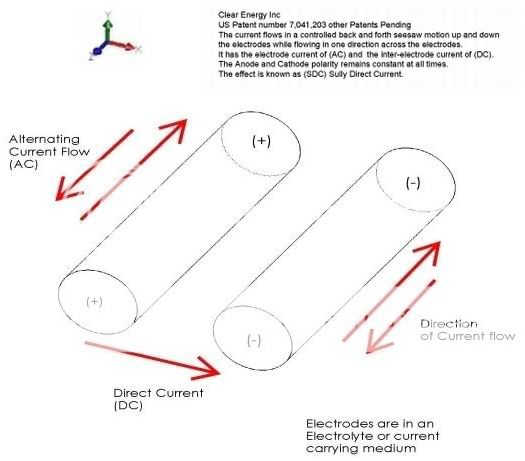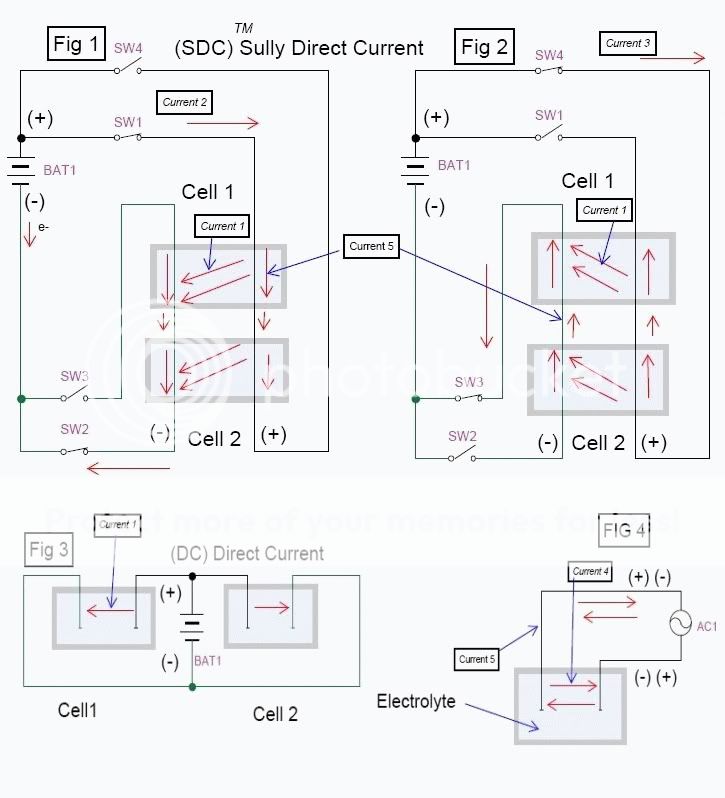It looks like you're using an Ad Blocker.
Please white-list or disable AboveTopSecret.com in your ad-blocking tool.
Thank you.
Some features of ATS will be disabled while you continue to use an ad-blocker.
share:
Emphasis mine. This description seems to be at odds with Mr. Sullivan's own description.
Its not at odds. You can change direction without reversing directions. The origin and destinations change, but the direction of travel from origin to destination does not switch. Current from cathode to anode is continuous DC, but current through the electrodes alternates without switching polarity.
The wire/electrode/coil has two single dimension connections which are the ends of the wires, and the third multi-dimensional connection being a fluid medium.
There are two kinds of currents flowing through the electrode. An alternating intra-electrode current, and a continuous DC inter-electrode current. All without switching anode, and cathode.
Each Electrode has two connections. As the connections are switched current flows through opposite ends of the electrode, but the same direction
through the fluid without switching polarity.


I see that you keep this thread alive and I don't know for what reason.
I think the 'sdc' circuit is clear enough for the most already, at least for the one that have some good basic knowledge in electronics, and does not require much further explanation.
As far as I can extract this from the answers given here, the disagreement in seeing SDC as a 'new current' is not because of a lack in understanding. Far in the opposite. So showing the SDC-Circuit in ever new ways will not change anything and also not contribute to a new discussion. The opinions are set.
Mind you to to ask, what's the point in keeping this thread alive?
Wouldn't it be time to just let the thread dieing the 'All is said' dead?
I think the 'sdc' circuit is clear enough for the most already, at least for the one that have some good basic knowledge in electronics, and does not require much further explanation.
As far as I can extract this from the answers given here, the disagreement in seeing SDC as a 'new current' is not because of a lack in understanding. Far in the opposite. So showing the SDC-Circuit in ever new ways will not change anything and also not contribute to a new discussion. The opinions are set.
Mind you to to ask, what's the point in keeping this thread alive?
Wouldn't it be time to just let the thread dieing the 'All is said' dead?
reply to post by Malichai
I know its not clear, but if you understand this you can better see the rest.
In a single dimensional world there are only three choices; Stay where you are, go forward, or go forward the other way. Electricity, at least the kind you know, is the same way. Anode - Cathode. Polarity is absolute. You go from one to the other. DC goes one way, only. AC goes one way then reverses direction. There is only one possible change in direction, reversal.
But we live in a three dimensional world. Current flow, electricity, is not restricted to flowing electrons. Any charged particle will do. Moving ions, plasma, semiconductors, etc.. are also current carrying mediums with special properties that are not limited to MASS.
Solid wire conductors, and other solid devices do not allow for mass to move except on a small scale that is insignificant. With fluids the mass can move. If you use DC current to move mass it can only go one way in an [almost] straight line. AC will move the mass forward then reverse. Net current flow comes to zero if potential and switching are perfectly 180 degrees out of phase.
The switched DC power supplies you have seen are simply a device for converting AC to DC. By itself you have an open circuit and the charge carriers do nothing. You must complete the circuit before any actions happen. And when you do two wires are connected to the power supply.
With SDC you have four connections to the power supply. In the example you see that the two poles, anode and cathode, each have two connections, not one. Each of the two coils has a connection on each end that connect to the same pole. This is switched back and forth, sort of like AC.
What happens between the two coils is not apparent at first glance, and you would need to look deeply into the dark art of electrolysis to understand. In and Out of the electrodes flows electrons, but electrons are not flowing through the fluid medium. It is ions flowing between. One side strips off an electron [or more]. This creates an ion. Now that the mass is charged it is attracted to its opposing polarity, the other coil. The mass moves through the medium and when it meets the other side it gets back an electron losing its charge. Now the electrostatic forces no longer effect the mass.
ELECTRONS DO NOT FLOW THROUGH THE WORKING PART
The effect of charge density on the ions is also not clear from simply looking. As we know, opposites attract. But what if there is not one single opposite? With commoner electricty the charge carriers, electrons, can only see one end of the tunnel or the other. With the Third Current the charge carriers, ions, etc.., can see everything if they exist in a fluid medium. The opposing pole is not a single point in the example. it is a wide area of charge. At every point where the coil touches the medium electrons will either be collected or distributed. But, because of the laws of potential and density, an equal amount of electrons will be transfered at all points along the coil, provided you have perfect conditions with the forging of the coils and the medium itself. Assuming that it is perfect. This means that the electrons will need to flow from one end of the coil to all points along the coil and out in an orderly fashion. But since they are all coming from the same place, the area closer to the door will have a greater CHARGE DENSITY.
Charge density determins the path of an ion [etc..] through a fluid medium. It heads towards the effective middle of the charge. One side is stronger than the other.
When the cycle advances the electrons go through the other door. The area of density switches to the other side of the coil. The path of the ion [etc..] changes.
Its like if your Mom called you up and asked you to come over because she needs help. You start heading down the shortest route, the straight path. Then your Aunt calls and says that she needs your help even more. So you take a different path. You change direction without reversing direction and going home. Then Mom calls you back and asks who is more important. So, you change direction again, but you don't dare go back home. After a while it might be best to turn off your phone and go home, but what good would it do? You have a phone at home....
The same thing is happening to the charge carriers. They go one way then they change direction without going back.

Now we have covered one and two dimensions. I can't start to explain how a third dimension may apply until after you wrap your head around two.
Two men on a horse.
[edit on 27-10-2007 by Malichai]
forum.physorg.com...
Check the Wizards Spel-ling and Gram-mar
I know its not clear, but if you understand this you can better see the rest.
In a single dimensional world there are only three choices; Stay where you are, go forward, or go forward the other way. Electricity, at least the kind you know, is the same way. Anode - Cathode. Polarity is absolute. You go from one to the other. DC goes one way, only. AC goes one way then reverses direction. There is only one possible change in direction, reversal.
But we live in a three dimensional world. Current flow, electricity, is not restricted to flowing electrons. Any charged particle will do. Moving ions, plasma, semiconductors, etc.. are also current carrying mediums with special properties that are not limited to MASS.
Solid wire conductors, and other solid devices do not allow for mass to move except on a small scale that is insignificant. With fluids the mass can move. If you use DC current to move mass it can only go one way in an [almost] straight line. AC will move the mass forward then reverse. Net current flow comes to zero if potential and switching are perfectly 180 degrees out of phase.
The switched DC power supplies you have seen are simply a device for converting AC to DC. By itself you have an open circuit and the charge carriers do nothing. You must complete the circuit before any actions happen. And when you do two wires are connected to the power supply.
With SDC you have four connections to the power supply. In the example you see that the two poles, anode and cathode, each have two connections, not one. Each of the two coils has a connection on each end that connect to the same pole. This is switched back and forth, sort of like AC.
What happens between the two coils is not apparent at first glance, and you would need to look deeply into the dark art of electrolysis to understand. In and Out of the electrodes flows electrons, but electrons are not flowing through the fluid medium. It is ions flowing between. One side strips off an electron [or more]. This creates an ion. Now that the mass is charged it is attracted to its opposing polarity, the other coil. The mass moves through the medium and when it meets the other side it gets back an electron losing its charge. Now the electrostatic forces no longer effect the mass.
ELECTRONS DO NOT FLOW THROUGH THE WORKING PART
The effect of charge density on the ions is also not clear from simply looking. As we know, opposites attract. But what if there is not one single opposite? With commoner electricty the charge carriers, electrons, can only see one end of the tunnel or the other. With the Third Current the charge carriers, ions, etc.., can see everything if they exist in a fluid medium. The opposing pole is not a single point in the example. it is a wide area of charge. At every point where the coil touches the medium electrons will either be collected or distributed. But, because of the laws of potential and density, an equal amount of electrons will be transfered at all points along the coil, provided you have perfect conditions with the forging of the coils and the medium itself. Assuming that it is perfect. This means that the electrons will need to flow from one end of the coil to all points along the coil and out in an orderly fashion. But since they are all coming from the same place, the area closer to the door will have a greater CHARGE DENSITY.
Charge density determins the path of an ion [etc..] through a fluid medium. It heads towards the effective middle of the charge. One side is stronger than the other.
When the cycle advances the electrons go through the other door. The area of density switches to the other side of the coil. The path of the ion [etc..] changes.
Its like if your Mom called you up and asked you to come over because she needs help. You start heading down the shortest route, the straight path. Then your Aunt calls and says that she needs your help even more. So you take a different path. You change direction without reversing direction and going home. Then Mom calls you back and asks who is more important. So, you change direction again, but you don't dare go back home. After a while it might be best to turn off your phone and go home, but what good would it do? You have a phone at home....
The same thing is happening to the charge carriers. They go one way then they change direction without going back.

Now we have covered one and two dimensions. I can't start to explain how a third dimension may apply until after you wrap your head around two.
Two men on a horse.
[edit on 27-10-2007 by Malichai]

Here is a image, that was very difficult to capture, of the split second where an electric arc completes the path. Note that it does not come from one side and go to the other. The two poles are opposing, but not EQUAL.
In a wire using electrons as charge carriers the same is not true, exactly.
I know its not easy to understand. Follow the diagram and the flow of ions.



Just a little something I drew up. Any electrical current fits into one of these three definitions. Actually, more like two, as pulsed DC can be defined as a kind of AC.
This “Sully DC” is like “Klein’s Gas” – an old idea with a new name.
Edit: Hmm. Forgot to label my axes. Those are V vs t graphs, of course, and my ±5V could be anything else.
[edit on 31-10-2007 by NRen2k5]
reply to post by Malichai
They've been using this same approach to generate cold plasma for a while. Pulsed DC. It's also useful for the Bifield-Brown ionic thrusters. Here's a circuit for building a high voltage, pulsed DC power supply: www.blazelabs.com...
Actually, after looking further, it doesn't look like the same thing. It seems I was wrong about that, but the link above may still interest some people. Seems like more of an electrolysis specific technique than new kind of current though.
[edit on 31-10-2007 by lifestudent]
It is a new form of electrode that allows EM effects in systems that require DC current.
They've been using this same approach to generate cold plasma for a while. Pulsed DC. It's also useful for the Bifield-Brown ionic thrusters. Here's a circuit for building a high voltage, pulsed DC power supply: www.blazelabs.com...
Actually, after looking further, it doesn't look like the same thing. It seems I was wrong about that, but the link above may still interest some people. Seems like more of an electrolysis specific technique than new kind of current though.
[edit on 31-10-2007 by lifestudent]
new topics
-
I hate dreaming
Rant: 10 minutes ago -
Is the origin for the Eye of Horus the pineal gland?
General Conspiracies: 1 hours ago -
Man sets himself on fire outside Donald Trump trial
Mainstream News: 2 hours ago -
Biden says little kids flip him the bird all the time.
2024 Elections: 2 hours ago -
The Democrats Take Control the House - Look what happened while you were sleeping
US Political Madness: 2 hours ago -
Sheetz facing racial discrimination lawsuit for considering criminal history in hiring
Social Issues and Civil Unrest: 2 hours ago -
In an Historic First, In N Out Burger Permanently Closes a Location
Mainstream News: 4 hours ago -
MH370 Again....
Disaster Conspiracies: 5 hours ago -
Are you ready for the return of Jesus Christ? Have you been cleansed by His blood?
Religion, Faith, And Theology: 7 hours ago -
Chronological time line of open source information
History: 8 hours ago
top topics
-
In an Historic First, In N Out Burger Permanently Closes a Location
Mainstream News: 4 hours ago, 14 flags -
The Democrats Take Control the House - Look what happened while you were sleeping
US Political Madness: 2 hours ago, 9 flags -
Thousands Of Young Ukrainian Men Trying To Flee The Country To Avoid Conscription And The War
Other Current Events: 15 hours ago, 8 flags -
A man of the people
Medical Issues & Conspiracies: 10 hours ago, 8 flags -
Man sets himself on fire outside Donald Trump trial
Mainstream News: 2 hours ago, 7 flags -
Biden says little kids flip him the bird all the time.
2024 Elections: 2 hours ago, 6 flags -
4 plans of US elites to defeat Russia
New World Order: 11 hours ago, 4 flags -
Are you ready for the return of Jesus Christ? Have you been cleansed by His blood?
Religion, Faith, And Theology: 7 hours ago, 3 flags -
Is the origin for the Eye of Horus the pineal gland?
General Conspiracies: 1 hours ago, 3 flags -
Sheetz facing racial discrimination lawsuit for considering criminal history in hiring
Social Issues and Civil Unrest: 2 hours ago, 3 flags
active topics
-
12 jurors selected in Trump criminal trial
US Political Madness • 88 • : FlyersFan -
Is the origin for the Eye of Horus the pineal gland?
General Conspiracies • 4 • : JoelSnape -
Man sets himself on fire outside Donald Trump trial
Mainstream News • 18 • : nugget1 -
Biden says little kids flip him the bird all the time.
2024 Elections • 9 • : FlyersFan -
Fossils in Greece Suggest Human Ancestors Evolved in Europe, Not Africa
Origins and Creationism • 72 • : Xtrozero -
I hate dreaming
Rant • 0 • : FlyersFan -
MH370 Again....
Disaster Conspiracies • 8 • : Lazy88 -
Do we live in a simulation similar to The Matrix 1999?
ATS Skunk Works • 27 • : purplemer -
Thousands Of Young Ukrainian Men Trying To Flee The Country To Avoid Conscription And The War
Other Current Events • 27 • : Xtrozero -
911 emergency lines are DOWN across multiple states
Breaking Alternative News • 8 • : nugget1
